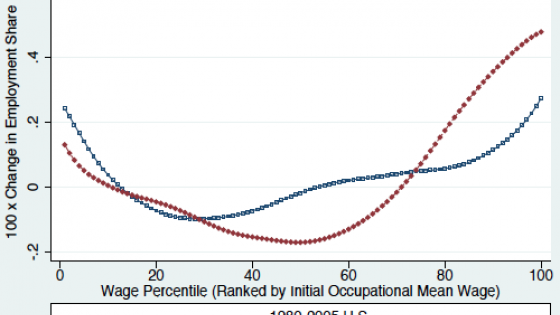In his assessment of the Brexit vote the day after it took place, former Prime Minister Tony Blair saw the key to the success of the Leave campaign as being the convergence of the political far left (the railing at bankers) and far right (the attacks on immigrants) that would ultimately be driven by a shared hostility to globalisation. As readers of his 24th June article in the New York Times were quick to point out, it may not be hostility to globalisation per se as much as a reaction to the decimation of the middle class and rising economic inequality that seems to accompany globalisation in high-income countries. But does globalisation in fact cause polarisation?
Job polarisation – the hollowing out of middle-class jobs that is accompanied by increases in low- and high-wage jobs – has been a reality in many high-income countries in recent years (Goos et al. 2014). The same countries saw a substantial increase in their foreign trade, which came in particular in the form of rising import competition from China during the 2000s. While job and earnings losses due to import competition may pose a challenge to the welfare state, without corresponding gains there are no losers and winners, no polarisation, and hence no fundamental threat to the very functioning of society. To date, the cause of polarisation is seen in computerised machines and robots replacing mid-wage earning workers (Autor and Dorn 2013, Goos et al. 2014, Michaels et al. 2014).
In a new paper, using administrative data on all workers matched to firms, we show that import competition, by leading workers either to move down or move up the occupational hierarchy, accounts for a substantial part of job polarisation in Denmark (Keller and Utar 2016). Denmark interesting not only because its job polarisation and globalisation patterns are typical of other high-wage countries (Figure 1 compares job polarisation in Denmark and the US), but also because Denmark is high on the list of countries that are said to be next in favouring exiting from the EU through a referendum (‘Dexit’).
Figure 1 Job polarisation in Denmark in perspective

One distinctive feature of our analysis is that we study polarisation by following almost one million Danish workers from their initial job to whatever occupation, firm, and sector they move to. Figure 2 depicts employment share changes between 2000-2009 among workers who were employed in the textile, manufacturing and service sectors, respectively, as of 1999. It shows that the employment trajectories of workers who were employed in any manufacturing industry as of 1999 exhibit strong polarisation, in contrast to the employment trajectories of service sector workers, who exhibit a pattern of ‘moving up’ or ‘skill-upgrading’. Because rising import competition with low-wage countries has been more striking in the tradable manufacturing sector than in services, this provides prima facie evidence of the importance of trade.
Figure 2 Changes in employment share between 2000 and 2009 by workers’ sector in 1999

While the emergence of China is felt as a major competitive shock by all manufacturing producers in rich countries such as Denmark, this is particularly true in the labour-intensive textiles and clothing sector, where the traditional comparative advantage of low-wage countries is compounded by trade liberalisation in form of import quota removals (the so-called Multi-Fiber Arrangement quotas) through China's 2001 entry into the WTO. Figure 3 shows the movements of Danish textile machine operators and assemblers, an important occupation for this industry in which workers typically receive mid-level wages.
Figure 3 Employment transitions of textile machine operators by trade exposure

First, the top two lines in the figure show the cumulative employment probabilities of textile machine operators working at firms manufacturing the same 8-digit products as those that saw quotas removed after 2001 (dashed), versus textile machine operators at firms that were not exposed to more import competition due to the quota removal (solid). The lines slope downwards, indicating that many of the universe of 1999 machine operators moved to other occupations in the following decade. Notice, however, that while 23% of the machine operators at the firms not exposed to the quota removal are still in that same occupation in 2009, this figure is only 15% for machine operators exposed to the quota removal. This difference of 8% is essentially the negative effect of import competition on mid-wage employment as machine operator.
Second, the two lower lines give the cumulative probabilities for machine operators moving to personal and protective service occupations, such as travel agents, housekeeping, childcare, hairdressers, and guards. Figure 3 shows that machine operators exposed to rising import competition move disproportionately into such service occupations, and because the latter are typically paying low wages, this implies that import competition can explain the employment increases in the lower tail of the wage distribution. Furthermore, rising import competition also pushes some workers disproportionately into high-wage occupations such as professionals and managers.
We confirm these results for the aggregate economy using instrumental-variables analysis, finding that import competition accounts for almost one in five lost mid-wage jobs in Denmark as well as a substantial part of the increase in low-wage employment. Importantly, rising import competition is also the force behind every tenth high-wage job in Denmark during this period, so there is clear evidence for employment polarisation in Denmark due to competition with China.
We also find that both technical change and offshoring are important factors for job polarisation. In contrast to import competition, they do not work as the sole explanations. Offshoring induces mid-wage workers to move down the occupational hierarchy, while mid-wage workers in occupations with reduced demand due to technological change tend to move up the occupational hierarchy.
Although Denmark is characterised by an equal income distribution compared to most countries, income inequality has been on the rise of late. Based on our regression results we estimate that rising import competition from China has accounted for 16% of the increase in earnings inequality in Denmark between 1999 and 2009. Most of this is due to changes in occupations, not in the hourly wages paid to workers. The pattern of trade-induced job polarisation emerges as a shift between sectors. Manufacturing jobs paying mid-level wages are lost at the same time when service sector workers see higher employment opportunities. The increase in low-wage employment is mostly in services, whereas high-wage job gains are split between services and manufacturing. There is no job polarisation pattern within manufacturing, because low-wage job opportunities in manufacturing disappear.
With import competition leading to the decline in mid-wage employment, it is natural to consider educational policies targeting workers in the middle of the distribution. Vocational education, which combines apprenticeships in firms with formal schooling, has not only long been part of the educational system in Europe, but is also being considered as a response to job polarisation in countries such as the US. Does vocational education reduce the chance of mid-wage employment losses and raise the odds for high-wage jobs relative to low-wage jobs?
With more than a third of Danish workers having vocational degrees, we document massive heterogeneity in worker performance across more than 3,000 different vocational degrees. Manufacturing specific vocational education, such as welding or tool making, reduces the chance of losing mid-wage jobs, but it does nothing to raise the odds for a high-wage job over a low-wage job.
In contrast, vocational education with a focus on services, such as for pharmacy technicians or finance clerks, eliminates the risk of moving into low-wage jobs due to import competition. Finally, vocational education in information technology greatly enhances a worker’s chance to move into high-wage employment. In sum, the forward-looking strategy towards a high-wage earnings profile is to focus on vocational education in technical, computer-oriented service sector vocations.
To conclude, our findings on the impact of globalisation are mixed. Yes, there is evidence that globalisation in form of rising import competition contributes to the polarisation and inequality in high-income countries. By the same token, globalisation not only leads to greater purchasing power for all by lowering goods prices, but it also accounts for a substantial part of all high-wage employment gains — one in ten jobs. In terms of future exits (Dexit, Nexit, Frexit, etc.), the task for policymakers is to make these gains felt by the majority of voters.
References
Autor, D, and D Dorn (2013), “The Growth of Low-Skill Service Jobs and the Polarization of the US Labor Market”, American Economic Review, 103 (5), 1553-1597
Autor, D, D Dorn, and G Hanson (2013), “The China Syndrome: Local Labor Market Effects of Import Competition in the United States”, American Economic Review, 103 (6), 2121-2168
Autor, D, L F Katz, and M S Kearney (2006), “The Polarization of the U.S. Labor Market”, American Economic Review: Papers and Proceedings, 96 (2), 189-193
Ebenstein, A, A Harrison, M McMillan and S Phillips (2014), “Estimating the Impact of Trade and Offshoring on American Workers using the Current Population Surveys", The Review of Economics and Statistics, 96 (3), 581-595
Goos, M, and A Manning (2007), “Lousy and Lovely Jobs: The Rising Polarization of Work in Britain”, The Review of Economics and Statistics, 89 (1), 118-133
Goos, M, A Manning, and A Salomons (2014), “Explaining Job Polarization: Routine-Biased Technological Change and Offshoring”, American Economic Review, 104 (8), 2509-2526
Keller, W, and H Utar (2016), “International Trade and Job Polarization: Evidence at the Worker-level”, CEPR Discussion Paper No. 11311
Michaels, G, A Natraj and J Van Reenen (2014), “Has ICT Polarized Skill Demand? Evidence From Eleven Countries Over Twenty-Five Years", The Review of Economics and Statistics, 96 (1), 60-77
Pierce, J R, and P K Schott (2015), “The Surprisingly Swift Decline of U.S. Manufacturing Employment”, American Economic Review, forthcoming
Utar, H (2015), “Workers beneath the Floodgates: Impact of Low-Wage Import Competition and Workers' Adjustment”, Bielefeld Working Papers in Economics and Management, No.12
Utar, H (2014), “When the Floodgates Open: "Northern" Firms' Response to Removal of Trade Quotas on Chinese Goods”, American Economic Journal: Applied Economics, 6(4): 226-250






